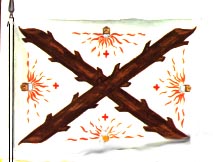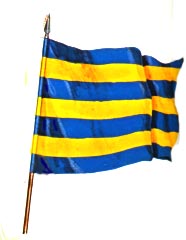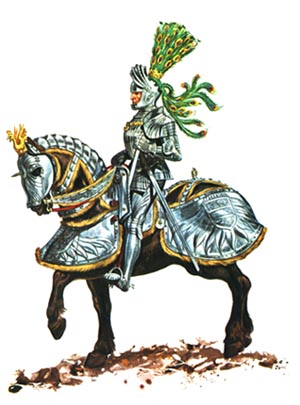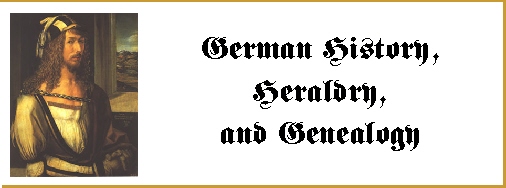Of the ancestors of Maximilian:
- Three were German
- Two were French
- Four were Italian
- Ten were Portuguese and Spanish
- Three were English
- Three were Polish
- One was Lithuanian
- Four were Russian.
.
Maximilian was a true European.
At a very early age Maximilian learned to draw and paint. He learned seven languages. He liked people of all positions in life. He enjoyed learning about them and their language.
Maximilian was first betrothed to Anne of Brittany. The marriage was celebrated by proxy. However Charles VIII (successor to Louis XI of France) has other ideas and Anne was forced to become Charles' wife.
He married (1)Mary of Burgundy (1457-1482), daughter of Charles, "the Bold," Duke of Burgundy (Belgium). Her farther, Charles died in 1477 at the battlefield of Nancy. When they were betrothed, they studied each other's portraits. At age eigtheen, Maximilian traveled to Burgundy to meet and marry his wife. This trip was to begin on May 20, 1477. Their marriage was solemnized on August 18, 1477. Their first child was Philip the Handsome. Philip was born at Bruges, on July 22, 1478. Eighteen months later their daughter, Margaret was born. In March 1482, Maximilian and Mary went hawking. Her falcon flew into the sky and then plummeted near her horse. Mary lost her balance and fell to the ground. Mary was pregnant and her injuries caused her death. Mary died at the Prisenhof, in Ghent, on March 27, 1482, at the age of twenty-five (25) years. After Mary's death he could not become guardian of his own children because they were heirs to the Burgundian duchy.
Maximilian married (2) Bianca Maria Sforza (1472-1510, daughter of Galeazzo Sforza, Duke of Milan, and the niece of the Milanese duke Ludovico Moro, in the year 1494. Bianca was barren thus no more heirs.
Duke Francisco Sforza controlled Milan and was a Habsburg ally. He died in 1535 without an heir.
Maximilian was Holy Roman Emperor (Sacrum Romanum Imperium) in 1486. Maximilian sent his young daughter to King Charles VIII of France as his prospective bride.

The standard of Maximilian
incorporating the Burgundian
Cross of Saint Andrew's
In 1491, Maximillian allied himself with the great prince of Moscow against the Polish Jagiellons, who were claiming Hungary. His other alliance with the Moscovites was to protect the The Teutonic Knights from the Poles. He wrote to the Grand Master of the Teutonic Order saying that Poland must be left inviolate for the sake of Europe as a whole. Maria Theresa agreed with his summary.
Maximilian's and Mary's children were:
- Philip I, "the Fair." Philip was born in Bruges in June 22, 1478. in Toledo, Spain; and died on September 25, 1506 in Burgos, Spain. Joanna/Juana was born on November 6, 1479, in Toledo. Spain; and died April 13, 1555, in Castillo, Tordesilles, Spanish Flanders, Belgium. Juana was the second daughter of Ferdinand, King of Castile and Aragon; and Isabella, would be Philip's wife. From 1497-1500 there were the deaths of Juan, the only son of Isabella (daughter of Ferdinand and Isabella) and Miguel, Isabella's only son. These deaths made Joanna and Philip heirs to the Spanish throne. Their son Charles was born in 1500, which united Spain, the Netherlands, and Austria, when he would become king. When Queen Isabella died, Philip, the Handsome, was regent for Prince Charles in Castile. Philip was buried in Granada Cathedral, Granada, Spain.
- Francis died in 1481.
- Margaret (1480-1530) married three times:
(1) Charles, Dauphin of France in 1483 (2) Prince Juan of Aragon in 1495 (3) Philbert of Savoy, Regent of the Netherlands, in 1501.
- Francis was stillborn in 1481.
His heirs, Ohilip and Margaret made a strong alliance with Spain.
Philip was Maximilian's heir. His marriage to Juana of Castile produced the following heirs:
Eleonora (1498-1558) married (1) Emmanuel I (1469-1521) in 1519. Emmanuel was the king of Portugal.(2) Francis I (1494-1547), King of France, in 1530.
Charles V (r. 1519-1556), later a Holy Roman Emperor, was born at Prinsenhof in Ghent(in the Duchy of Burgundy), on February 24, 1500 and died in Yuste on September 21, 1558. Charles married Isabella of Portugal, daughter of Emmanuel, King of Portugal, in 1503. Charles secured financial support from Jacob Fugger and the Welser family of Augsburg.
Isabella (1501-1526) was born on July 18, 1501. Isabella married Christian II (1481-1531) of Denmark in 1515. Isabella died January 19, 1526.
Ferdinand I, later a Holy Roman Emperor, was born in Alcala de Henares, Madrid, Spain, on March 10, 1503, and died in Vienna on July 27, 1564. in Wien, Austria. Ferdinand married Anne Jagellon (1503-1547), daughter of Wladislaw II, King of Bohemia and Hungary, in 1521 in Linz, Oberhosterreich, Austria. Anne was born on July 23, 1503, and died January 27, 1547, in Praha, Czechoslavakia. Anne was made Queen of Hungary, in 1521. Ferdinand's daughter, Elizabeth (1526-45), married Sigismund of Poland. Maximilian (1527-1576) was Ferdinand's son. Maximilian II was the emperor of the Holy Roman Empire, and King of
Bohemia and Hungary.
The Children of Ferdinand and Anna were:
Elizabeth (1526-1545)
Maximilian II, Holy Roman Emperor, was born on July 31, 1527 and died October 12, 1576.
Anna (1528-1590)
Ferdinand (1529-1595)
Marie (1531-1581)
Magdalene (1532-1590)
Katharine (1533-1572)
Eleonore (1534-1594)
Margarethe (1536-1567)
Johann (1538-1539)
Barbara (1539-1572)
Karl (1540-1590)
Ursula (1541-1543) Anna, Ursula's mother was age 38 years old at this time.
Helene (1543-1574)
Johannes (1547-1578) was born January 24, 1547 and died April 10, 1578 (at age 1 year, 3 months) Anna, Johannes' mother was age 44 by the time her last son was born. She was nearing her menopausal period in life. Which explains her death (January 27, 1547) a three days after the birth of her son.
Mary (1505-1558)
Catherine (1507-1578) married John III, King of Portugal (1502-1557).
Philip's Illegitimate children were:
Margaret of Parma - whom he legitimized.
John of Austria was recognized after the death of his son Charles V.

Drawing by Gerry Embleton
The Standard of the Fugger Family
In 1511, the Pope formed a Holy League with Spain, Venice, and Henry VIII of England against France. Maximilian saw his chance to seal the fate of France, and to secure Italy, so he also joined the League.
A meeting was held between Poland and King Maximilian regarding the Turks. They met in Vienna in 1515. Maximilian was penniless, at this time, and borrowed $4,000 guldens from Jacob Fugger of Augsburg. Many of Maximilian's undertakings were financed by the Fuggers, who bore the cost of the imperial election of Max's grandson, Charles V. Max received King Vladislav, Louis and Anna (the royal children), and King Sigismund of Poland. After this conference, Louis, the nine-year old king of Bohemia and Hungary was betrothed to Maximiloan's grand-daughter, the Infanta Maria. Twelve year old Anna of Hungary was betrothed to Ferdinand in 1521, having been previously betrothed to Ferdinand's grandfather. The little prince, Louis, was adopted by Maximilian, as his son, in 1515.
On February 6, 1598, Maximilian was made "Roman Emperor Elect." King Louis was killed while fighting the Turks at Mohacz on August 29, 1526.
Juan, the only son of the "Catholic Kings" married his daughter, Margaret (1489-1530), who was rejected by Charles VIII.On February 6, 1598, Maximilian was made "Roman Emperor Elect."

Emperor Maximilian I in his armour
illustrated by Gerry Embleton
in The Landsknecht
Men-at-Arms Series #58
Osprey Publishing
Notice the Peacock Helm
Peacocks in Myth and Legend ... Peacock Helms
Maximilian begun planning his mausoleum as early as 1502. On January 12, 1519, "the last knight" died at Wels. His heart was embalmed and carried to Bruges and reunited with his first wife, Mary of Burgundy. His tomb at Innsbruck was left empty. Instead he asked to be buried under the steps of the Church of St. George at Wiener Neustadt. Wiener Neustadt is a city in east-central Austria. Many Germans look on Maximilian as the last emperor of the Holy Roman Empire.
ANCESTORS OF MAXIMILIAN I:
I. Albrecht IV, Count of Habsburg died in 1240. He married Heilwig (d. 1260), daughter of Ulrich III, Count of Kyburg.
II. Rudolf I of Habsburg (1218-July 15, 1291) married (1) Gertrude of Hohenburg in 1245 (2) Elizabeth of Bohemia in 1284 (no issue). A forerunner of the Landsknecht unit fought in 1276 for Rudolph von Habsburg.
III. Albrecht I (1248-1308), Holy Roman Emperor, and Duke of Austria in 1282. Albrecht married Elisabeth of Carinthia, daughter of Meinberd IV, Count of Tyrol.
IV. Albrecht, "the Wise" (1298-1358) ruled Austria, Styria, And Alsace. Albrecht married Joanna (1300-1351), daughter of Ulrich II, Count of Pfirt, in 1324.
Siblings of Albrecht were:
- Rudolph III (1282-1307)
- Frederick I (1286-1330)
- Elizabeth died in 1352
- Leopold I (1290-1326)
- Henry (1299-1327)
- Otto (1301-1339)
V. Leopold III/Duke Leopold of Habsburg, ruled Austria, Tyrol, was Duke of Styria in 1351, and Carinthia. He was killed at Sempuch in 1396. Leopold married *(1)Catherine of Gorizia (2) Viridis Viscounti in 1565.
Siblings of Leopold were:
- Rudolph IV (1339-1365)
- Margaret (1346-1366)
- Frederick III (1347-1362)
- Albrecht III (1348-1395)
VI. Ernest I, "the Iron" (1377-1427) married Cimburga (1399-1429), daughter of Ziemovit, Duke of Mazovia.
Siblings of Ernest were:
- William (1370-1406)
- Leopold IV (1371-1411)
- Frederick IV (1382-1439)
VII. Frederick III (1415-1493), father of Maximilian II (1459-1519). emperor of the Holy ROman Empire (r. 1493-1519).
Siblings of Frederick III were:
- Margaret (1416-1486)
- Albrecht VI (1418-1463)
- Catherine (1420-1493)
SOURCES:
Friedrich, Herr. The Holy Roman Empire. Translated by Janet Sondheim. London: Phoenix Press, 1967.
Koch, H.W. History of Warfare. New York: Gallery Books, 1981.
Maclagen, Michael. Lines of Succession: Hearaldry of the Royal Families of Europe. New York: Barnes & Noble Books, 2002.
Midelfort, H.C. Erik. Mad Princes of Renaissance Germany. Charlotteville: University Press of Virginia, 1996.
Miller, Douglas. The Landsknechts. Man-at-Arms Series #58, London: Osprey [Reed International Books Ltd], 1997.
Richards, John. Landsknecht Soldier. Warrior Series, London: Osprey Publishing, 2002.
Wheatcroft, Andrew. The Habsburgs: Embodying Empire. New York: Penguin Books, 1996.
RELATED LINKS:
Austrian and German Crown Jewels
Malbork, Fortress of the Teutonic Knights
The Teutonic Knights
Home
You are the  visitor since December 7, 2003
visitor since December 7, 2003
Webmaster: Margaret Odrowaz-Sypniewski, B.F.A.,
Last updated on July 3, 2006
© 2000 Maggie973@aol.com
This page is hosted by


 ...
... 
